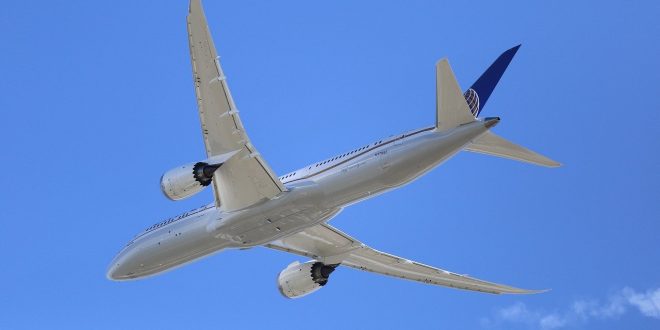Climate change activist and Nobel Peace Prize nominee Greta Thunberg has made headlines for eschewing flying in jets to help reduce her carbon footprint. In 2019, she sailed across the Atlantic from New York rather than fly home to Sweden.
Like many forms of transportation, airplanes emit the greenhouse gas carbon dioxide as they wing overhead. Airplanes emitted nearly 1 billion tons of CO2 in 2019, a bit more than 2% of total global CO2 emissions and 12% of all transportation carbon emissions. But as global economies and populations grow, the number of airline passengers could nearly double to 8.2 billion persons in 2037, creating an even greater peril.
Some airlines have made it a priority to find ways to cut carbon emissions on their current fleets to make travel more sustainable. Others are exploring different kinds of fuels, such as biofuels and electricity. In the meantime, some passengers are looking at ways they can offset the carbon emissions they add while in the air by being more eco-conscious on the ground
Making Flights More Eco-Friendly
Airlines are working to make their fleets more efficient, thereby using less fuel and cutting CO2 emissions. Newer aircraft, from the huge Airbus A350 to smaller regional jets like the Embraer E2 series, burn up to 20% less fuel.
An innovation called the winglet is a vertical piece that attaches to an airplane’s wing to make it more aerodynamic and help decrease fuel consumption by 4%. American Airlines and Europe’s Ryanair are among airlines employing winglets.
Airlines are also putting their aircraft on a diet; the less they weigh, the less fuel they consume. One example is Scandinavian Airlines (SAS), which discontinued bringing carts full of duty-free items on international flights as a way to shed weight. Other airlines are focusing on their fuel use on the ground. Jetblue is increasingly using electric-powered vehicles to on- and off-load luggage on airplanes.
Some think it might be best to create flight rationing, while others believe support should go to the countries that are undertaking sweeping initiatives for the environment like Saudi Arabia, which limits points of entry through its borders based on Visa requirements. Saudi Arabia and the United Nations Environment partnered to improve environmental protection in 2019. Using a $25 million agreement, the UN will provide help on climate change, air quality, environmental regulations and other issues. The combination of these new initiatives and the control of its borders have the potential to help Saudi Arabia control pollution and environmental changes more thoroughly than many of their Middle Eastern neighbors.
Carbon Offsetting
The UN is also working with the aviation industry to reduce carbon emissions. Called the Carbon Offsetting and Reduction Scheme for International Aviation (CORSIA), the program requires airlines to make up for their CO2 emissions by reducing them by the same amount elsewhere. This so-called offsetting means the airlines buy credits so that environmental protection activities will be implemented, thereby canceling out the environmental impact.
Since the technology for sustainable air travel is still advancing, many individual travelers have taken to carbon offsetting their flights. By calculating their carbon footprint in the miles they’ve traveled, people are offsetting the carbon spent in flight with green practices like planting trees or finding ways to conserve energy in their homes.
Individuals can also participate in carbon offsetting by calculating the amount of carbon their seat on a flight was responsible for and paying a company for its work in renewable energy, reforestation or capture of the greenhouse gas methane from landfills and mining. Sites such as Green-e and CO2OL Effect list carbon-offsetting projects that have been verified.
Some airlines offer carbon offset options when you book your flight, charging an extra fee that goes to an offset plan. Australian airline Qantas says it has the largest offset program of any airline, offsetting more than 3 million tons of carbon emissions since 2007. One project that passengers can donate to is a fire abatement program run by indigenous Australian landowners. Cathay Pacific also offers passengers an online calculator to figure their emissions and options to buy offsets.
Promising Alternative Fuels
Just as electric vehicles have taken to the road, the aviation industry hopes that electric planes will someday be able to make an impact in the sky. In 2019, SAS partnered with Airbus to research ways to make large electric and hybrid airplanes feasible.
Massachusetts-based Cape Air plans to use the electric Israeli-built Eviation Alice aircraft with nine seats to ferry passengers around the Northeast by 2023. The planes will have a range of about 650 miles. They will cost the airline about 40% less to operate because the electric motors are easier to maintain, and electricity will be cheaper than jet fuel.
Biofuels made from plants, including algae, grasses, cooking oil and fruit also have the potential to cut CO2 emissions. Currently, these fuels are expensive to produce, and some airlines, including United, American and Air France are mixing small amounts of biofuel in with conventional jet fuel. Alaska Airlines, in partnership with Boeing, plans to use biofuel for all of its new planes in flights from Seattle Tacoma International Airport in 2021. Kerosene is another fuel that may cut down on CO2 emissions, and Qatar Airways is now studying ways to use it for cleaner-burning flights.
While innovations to improve the environmental impact of flight take time, change is coming to the industry. Making air travel more carbon-friendly through less expensive biofuels, improved jet fuel efficiency and new electric airplanes won’t happen overnight. But changes are likely to soar in the near future if youth activists like Thunberg continue to inspire the next generation to become advocates for the environment, which will help sustainable air travel innovations become a reality for everyone.

 Alternative Energy HQ solar power for homes, wind energy, and bio fuel issues
Alternative Energy HQ solar power for homes, wind energy, and bio fuel issues








